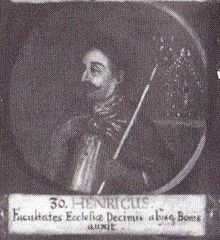Heinrich I of Rusteberg

Heinrich I von Rusteberg (wrongly also called Heinrich I von Wernigerode ) (* around 1200 ; † 1257 in Hildesheim ) was Bishop of Hildesheim from 1246 to 1257 .
Origin and early years
He came from the family of Rusteberg from the Eichsfeld , as Vice Dominus serving the archbishops of Mainz were. For a long time he was mistakenly regarded as the Count of Wernigerode . The only indication of this is a coin that shows the image of a bishop and the coat of arms of the Counts of Wernigerode without any inscription. Various members of the von Rusteberg family come into question as fathers (Heidenreich I. 1148–1194, Helwig 1148–1196, less likely Dietrich 1204–1236 / 39).
There is no evidence of Heinrich's early years. In 1228 he was a scholar at St. Martin in Heiligenstadt . There he is attested as provost in 1230. As such, it appears in documents until 1245. Since 1232 he also had a benefice in the Peterstift in Fritzlar and was there in 1236 scholaster. A seal shows him in this position as a seated teacher who punishes a kneeling student with a rod. It is not known whether he actually exercised this position himself or whether he only supervised the teaching staff. At times he was also the provost's deputy in Fritzlar.
It can be assumed that he belonged to the cathedral chapter in Hildesheim from around 1234 . Actually named as a former canon , he was only named after his election as bishop.
Hildesheim schism
The election to succeed Bishop Konrad II of Hildesheim was not clear. The majority of the canons with Provost Reinold von Dassel had spoken out in favor of Heinrich von Rusteberg. A minority elected an opposing bishop in Hermann von Gleichen , although he had not yet reached the canonical age of thirty.
Bishop Heinrich received the regalia from King Heinrich Raspe shortly before his death in 1247 . It was consecrated by Archbishop Siegfried III. from Mainz . This supported his position with a letter to Pope Innocent IV. The Pope confirmed the legitimacy of Heinrich's election. Hermann von Gleichen was supported by his family, Otto von Braunschweig and Count Günther IV von Käfernburg . This side claimed that the papal legate in Germany had designated Hermann as bishop. To what extent this is true cannot be clarified, especially since the Pope would then have opposed the decision of his legate.
As a result of the unclear choice, there was a schism in the Hildesheim Church that lasted about three years. It was associated with armed conflicts. The financial burdens were considerable. Immediately after the unclear election, Hermann von Gleichen had apparently succeeded in bringing almost the entire diocese area under his control. Heinrich was only able to maintain the Winzenburg . The city of Hildesheim was probably not in the hands of the enemy either. The Pope commissioned the Archbishop of Mainz to help Heinrich von Rusteberg get hold of the Hildesheim Monastery. Bishop Heinrich possibly proceeded against his opponents with the interdict . Innocent IV summoned Hermann von Gleichen to Lyon in vain . Instead of him, Bishop Heinrich traveled to Lyon. The matter dragged on without any further decision until 1249 the Bishop of Strasbourg was commissioned to enforce Henry's rights. The two competitors were again summoned to the Pope in Lyon. This time Hermann appeared while Heinrich was represented. The Pope decided again against Hermann. Heinrich first registered as bishop in Hildesheim in June 1250. To compensate, Hermann was made Bishop of Cammin .
Political and spiritual action
Apart from the contacts to enforce his claims, Heinrich's contacts with the Pope were few. In contrast to his predecessor, who still played an important role in imperial politics, this was no longer the case with Heinrich, whose episcopate fell during the interregnum . He was seldom near King William of Holland . It is characteristic of the loss of importance of the king as the last decision-maker that neither Hermann nor Heinrich appealed to the king during their dispute. For both, the Pope was the only decisive authority.
With regard to the promotion of monasteries and other spiritual institutions, Heinrich made little prominence.
Although the bishop needed considerable financial resources for his warlike ventures and had to pledge some goods, the overall financial situation was comparatively good and the bishop was even able to acquire new possessions and rights, which he usually handed over to the cathedral chapter. During this time, this has become significantly more important in worldly matters.
In 1249, the bishop confirmed older rights and duties of the city of Hildesheim, which had long been interpreted as granting city rights.
In 1255 Duke Albrecht von Braunschweig took Wolfenbüttel in connection with the Asseburg feud to eliminate the Staufer supporters there. Heinrich had already taken the Wolfenbüttel side in 1256. The duke managed to take some of Hildesheim's castles. However, Archbishop Gerhard I intervened in favor of Heinrich's feud and was even captured in 1257. Duke Albrecht allied himself in 1256 with Braunschweig , Goslar , Hanover and Hildesheim . The city turned against its own sovereign. The attempt of the bishop to proceed against Albrecht and his allies with the interdict failed because of a papal privilege. Even the Brunswick churches were removed from the dioceses of Hildesheim and Halberstadt . The bishop died before the feud ended.
literature
- Nathalie Kruppa, Jürgen Wilke: The Hildesheim bishops from 1221 to 1398 . Berlin, New York 2006 ( Germania Sacra NF 46) pp. 133-171
| predecessor | Office | successor |
|---|---|---|
| Konrad II. |
Bishop of Hildesheim 1246–1257 |
Johann I. |
| personal data | |
|---|---|
| SURNAME | Heinrich I of Rusteberg |
| BRIEF DESCRIPTION | Bishop of Hildesheim (1246–1257) |
| DATE OF BIRTH | around 1200 |
| DATE OF DEATH | 1257 |
| Place of death | Hildesheim |